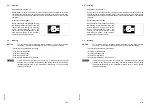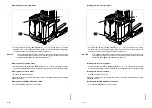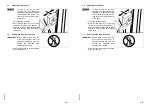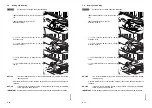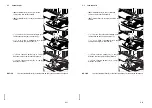
E 47
0
608
.USA
When loading and unloading railroad cars, appropriate precautions must be taken to
prevent the car from being moved. Use wheel locks, parking brakes or other
appropriate devices to prevent movement during loading and unloading.
Proceed with caution to avoid making contact with service installations below the
ceiling – such as lighting, cabling, pipe systems, sprinkler systems, etc.
When driving an industrial truck onto or off of trailers not coupled to the truck,
appropriate supports must be used to prevent the trailer from tipping backward or
sideways.
Rail cars or trailers may not be moved by a powered industrial truck that is not
specifically designed for that purpose.
An industrial truck must not be used to open or close the doors of railroad cars unless
the truck is fitted with a special device for opening and closing railroad car doors and
the operator has been trained to use this device.
When using a device to open or close railroad car doors, the truck must be moved
parallel to the railroad car and the force exerted parallel to the movement of the door.
When inserting the device to open and close railroad car doors, take care to prevent
the strong forces from damaging the doors and / or truck. The entire procedure for
opening the door must be visible to the operator. The industrial truck must always be
positioned in such a way that the person on the load platform is protected when the
locking pin in the door is removed. The operator must inform his or her supervisor or
proceed in accordance with the instructions if an unusually strong force is required to
open the door of a railroad car.
Ground and ground surface conditions:
The ground must be maintained in an
appropriate manner to keep it free from dirt and liquids which would adversely affect
the safe operation of the truck.
Travel surface:
The surface on which the industrial truck is used must be maintained
in an appropriate manner to provide the expected traction for traveling, steering and
braking under the prevailing environmental conditions.
The details given on the industrial truck nameplate are based on a horizontal, dry
surface and a minimum coefficient of friction of the drive and braking tire of 0.6. Other
ground conditions may affect the safety of the industrial truck and require the nominal
power of the truck to be adjusted accordingly.
Physical environment:
The physical environment – including temperature, relative
humidity, weather conditions (e.g. on uncovered loading ramps), air quality
(explosive, containing particles and / or gaseous components) – is also an aspect of
the design criteria for an industrial truck. Changes to the environment should be
checked accordingly to ensure that they have no adverse effects on the safety
systems of the industrial truck.
Radiated emissions:
Many devices radiate energy, such as electromagnetic,
electrostatic or optical energy, which can adversely affect the operation of the
industrial truck. Equally, the vehicle systems can also emit energy, which can have a
negative effect on other systems and / or on personnel.
The owner should contact the industrial truck manufacturer if there is reason to
suspect that interference is occurring. The acceptable conditions for the industrial
truck are laid down in an agreement between the owner and the industrial truck
manufacturer.
E 47
0
608
.USA
When loading and unloading railroad cars, appropriate precautions must be taken to
prevent the car from being moved. Use wheel locks, parking brakes or other
appropriate devices to prevent movement during loading and unloading.
Proceed with caution to avoid making contact with service installations below the
ceiling – such as lighting, cabling, pipe systems, sprinkler systems, etc.
When driving an industrial truck onto or off of trailers not coupled to the truck,
appropriate supports must be used to prevent the trailer from tipping backward or
sideways.
Rail cars or trailers may not be moved by a powered industrial truck that is not
specifically designed for that purpose.
An industrial truck must not be used to open or close the doors of railroad cars unless
the truck is fitted with a special device for opening and closing railroad car doors and
the operator has been trained to use this device.
When using a device to open or close railroad car doors, the truck must be moved
parallel to the railroad car and the force exerted parallel to the movement of the door.
When inserting the device to open and close railroad car doors, take care to prevent
the strong forces from damaging the doors and / or truck. The entire procedure for
opening the door must be visible to the operator. The industrial truck must always be
positioned in such a way that the person on the load platform is protected when the
locking pin in the door is removed. The operator must inform his or her supervisor or
proceed in accordance with the instructions if an unusually strong force is required to
open the door of a railroad car.
Ground and ground surface conditions:
The ground must be maintained in an
appropriate manner to keep it free from dirt and liquids which would adversely affect
the safe operation of the truck.
Travel surface:
The surface on which the industrial truck is used must be maintained
in an appropriate manner to provide the expected traction for traveling, steering and
braking under the prevailing environmental conditions.
The details given on the industrial truck nameplate are based on a horizontal, dry
surface and a minimum coefficient of friction of the drive and braking tire of 0.6. Other
ground conditions may affect the safety of the industrial truck and require the nominal
power of the truck to be adjusted accordingly.
Physical environment:
The physical environment – including temperature, relative
humidity, weather conditions (e.g. on uncovered loading ramps), air quality
(explosive, containing particles and / or gaseous components) – is also an aspect of
the design criteria for an industrial truck. Changes to the environment should be
checked accordingly to ensure that they have no adverse effects on the safety
systems of the industrial truck.
Radiated emissions:
Many devices radiate energy, such as electromagnetic,
electrostatic or optical energy, which can adversely affect the operation of the
industrial truck. Equally, the vehicle systems can also emit energy, which can have a
negative effect on other systems and / or on personnel.
The owner should contact the industrial truck manufacturer if there is reason to
suspect that interference is occurring. The acceptable conditions for the industrial
truck are laid down in an agreement between the owner and the industrial truck
manufacturer.
Summary of Contents for ETR 314
Page 1: ...Operating instructions 50 452 907 ETR 314 320 u 06 06 11 09 07 08 E Manual de instrucciones...
Page 7: ...0608 USA I 4 0608 USA I 4...
Page 9: ...0606 USA A 2 0606 USA A 2...
Page 24: ...D 9 0107 USA D 9 0107 USA...
Page 26: ...D 11 0107 USA D 11 0107 USA...
Page 103: ...0107 USA F 10 0107 USA F 10...
Page 123: ...0708 USA G 20 0708 USA G 20...
Page 135: ...0608 E I 4 0608 E I 4...
Page 137: ...0606 E A 2 0606 E A 2...
Page 152: ...D 9 0107 E D 9 0107 E...
Page 154: ...D 11 0107 E D 11 0107 E...
Page 225: ...0608 E E 66 0608 E E 66...
Page 235: ...0107 E F 10 0107 E F 10...
Page 255: ...0708 E G 20 0708 E G 20...

